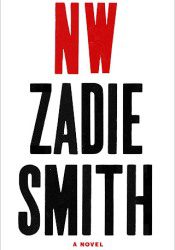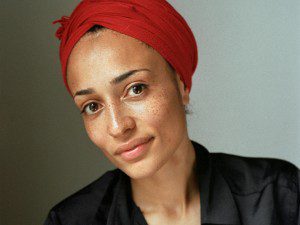
The fat sun stalls by the phone masts.
This is how Zadie Smith opens her latest novel, NW, and how appropriate–that something so fiery and core-hot, so screaming and universal could appear dumbfounded, loafing, stagnant.
Meet North West London, a relative dystopia from those adolescent promises that London made Smith’s crew of characters. Smith is clever in her exo/indo exploration of a city–zooming from big picture to small, from street-view to teacup. This is how we come to know this city, where sneakers hit high notes and busses sigh. Where voices ring clear as day through phone wires and open windows. Where men lounge naked, where women joke about white girls, dildos, good men, worthless men, mildewed offices and rum and coke. “Look, there on the library carpet between Science Fiction and Local History–a knotted condom filled with sperm.
Static cloud of a sigh.”

How we experience time is at the forefront of this novel–how, in present tense we are messy, bored, restless, critical, passive aggressive, analytical, reactive, and somehow fragmented in our ability to make meaning out of our soundscape, to tell the difference between sound and sight, the words of a lover and the words on a newspaper front page. Perhaps that’s why Smith creates a panoply of forms in the first two sections of NW–to expose us to the non-tidy nature of a present tense reality. She uses small conflicts–a visitor named Shar who serves as both an antagonist and a blessing to the eerily quiet relationship between main character Leah and her husband Michel–to spin off into chapters that do more to characterize our heroes than solve conflicts. In fact, at the discouragement of nearly everyone else, Leah seems to welcome Shar’s intrusion of her household and even seek out further interaction. This gives us a ramp into the dissatisfied world of Leah, the disappointments of domestic life, and the curiosity for danger that Leah will later (earlier) develop as we span her past for clues about her unhappiness. Smith seems to be saying, Let’s get down to it, with her bursts of poetry, lists, and fragments.
Speaking of main characters, who is it? NW follows four characters through four different fragmented plots, but the most striking narrative thread of all is that of the friendship between Leah and her best friend Natalie (formerly known as Keisha.) The main character of the book seems not to be a person, or even a city, but the bond created between these two women that faces a journey through the domestic and social realities of their city. While social class never fully divides them, their divergent life choices pose trials to their partnership. Both women find themselves fish out of water: Natalie–a black woman attending law school among London’s loafered elite; Leah–a sole white woman married to a black man in a black neighborhood and workplace. While reading I found myself so enthralled with Leah and Natalie that I sped through other channels to get back to what I found to be the heartbeat of the book.
Leah’s and Natalie/Keisha’s story picks up in Host, the book’s most rewarding section which begins nearly halfway through the book. In it, Smith draws tight vignettes of Leah and her best friend Keisha, (who later becomes known as Natalie.) Keisha and Leah explore all the beautiful, mysterious, usual young adolescent female things, but they each teeter between light and dark tropes: sexual terror / sexual bliss; terrorizing freedom / blissful freedom; the terror of beauty / the bliss of beauty. We watch them mature, depart, converge, intertwine, melt down, and rise through short blocks of prose that mirror a photo album. Leah (a swirl of popular culture, collegiate psuedo-philosophy, indie music and drugs) appears on the outside to be crafting an identity but in the end turns to Natalie for guidance. More complex is Natalie’s rise into her body and self as she meets a man who captivates her and begins to burst from her shell of identity-seeking submission. But this will be merely the beginning of her search for a form to fit her organic self.
Smith mirrors this search for form with her writing style and language, which perhaps challenges us to give this book some space and patience–much like we might lend to a human in limbo, searching to rebuild or re-raise oneself. If we hang in there long enough, the reward is far greater than the payoff of an easy plot structure and predictable climax and resolution.
NW, then, becomes Leah’s and Natalie’s canvas, a world created by their dreams, desires, question marks, and inevitably divergent paths toward womanhood. It’s a portrait of two women who never forsake one another, never double-cross, never lose the fundamental platform on which their dreams were built. What Smith does with form only illuminates the mysterious, shapeless, water-like movement of a female experience, sharpened at times by curt words and knife-blade images. If the reader hangs on and puts in the time with these language-driven moments of the book, what follows is a payoff of photographic flashbacks that bring relief.
Almost like life.
As the book winds back out of vignettes into longer chapters toward the end, these moments give us a “sense” or a shadow over the general mood of the book…one in which there is not quite yet a story. Or, in a sense, the lack of story is the story. Redemption, resolution, and reassurance, of it was all worth it, of the right choices were made are simply not there.
No, there are still characters, and there is a setting, and it is almost as though this journey has taken us to a point of a conflict in the end–another moment of mundane disagreement which characterizes these North West Londoners and their views, ideas, philosophies, and self-reflections. But no, there is no narrative payoff, no tight ending to validate the journey. And perhaps that’s the point: Who these women were when they met–Natalie an alienated, ghost-cry of a woman, Leah a struggling idealist with contempt for social constructs–is who they are when we end the book. Their paths are female, circular, back to home-base, back to themselves, back to back.




